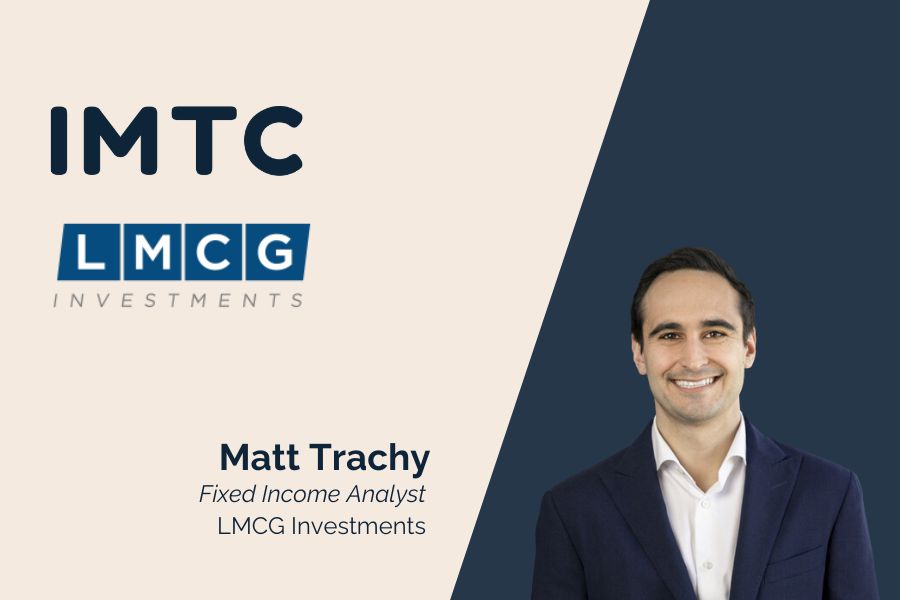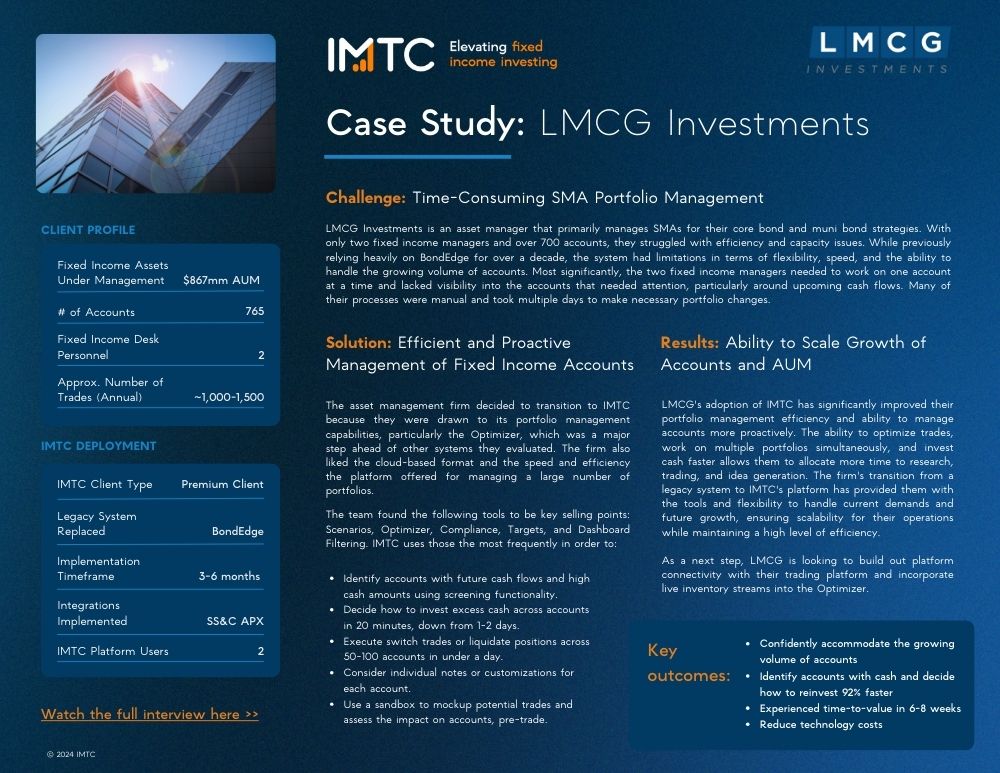LMCG Investments Case Study: Scaling Fixed Income Account Management

Navigate through the video by clicking on the chapter markers!
———
The IMTC team sat down with Matt Trachy of LMCG Investments to learn more about his experience as an IMTC client. Watch the full video interview, view the PDF highlights, or read the transcript below.
Learn more about LMCG Investments here.

Tell us about your firm.
LMCG is an asset management firm. We have several different types of products but the fixed income team works primarily with wealth management clients and it’s implemented through separately managed accounts. The two strategies that we offer are a traditional core bond product that is focused on taxable investors. We’re looking to generate return through investing in traditional style corporate bonds, government bonds, a mix of both of those. We also have tax exempt muni strategy that focuses a bit more on generating tax exempt income and principal protection and that’s for tax sensitive clients who are in specific states, and we’ll try to customize portfolios around that. We also do have ETF strategies that try to traditional bond strategies focused more so for investors with smaller account sizes.
LMCG’s a small firm only between like 40 and 50 employees right now and within that we only have two dedicated fixed income managers for our product. And you know within our business fixed income is a significant portion of that business and we manage over 700 accounts, which means that the two of us wear many different hats.
Why did you bring on IMTC and what pain points did it address?
The decision to move to IMTC was a pretty big one for us. We had been using another system BondEdge for about 10 plus years before that and we were very dependent on that system in our day-to-day operations. And when we were shown IMTC, we we’re just really impressed by the speed, the flexibility, some of the options that it offered just didn’t seem to be in place for the systems we’ve been using and in some of the competitors we looked at. You know, one thing that really caught our attention was more so the portfolio management side of things, to be honest. You know first and foremost IMTC’s optimization ability seemed to be a new and a major step ahead of other systems that we’ve seen in recent years. We’ve never seen someone implement something like that and it really piqued our interest. You know the cloud-based computing format, it seemed to work better than what we had. Being able to work on multiple accounts really quickly was something that was somewhat of a hindrance in our other system.
And you know IMTC just seemed to have more thoughtful solutions to how we could optimize working with the number of portfolios we have and how we could use the system not just to improve our work, but to improve our workflows. Scenarios and optimizers have really smoothly allowed us to work on multiple portfolios in one go in a way that we didn’t have before in BondEdge was really clunky. You had to go in and do each account, account by account by account by account. And now we really with IMTC we’ve been able to run scenarios across 50 to 100 accounts. We’ve been able to execute switch trades where we’re selling out an entire position and we’re moving into a new position across hundreds of accounts in one day where we would have spent a day to two just kind of lining these up. So it’s really provided us with a lot of opportunity to just be faster, be nimbler. And at the end of the day, that was kind of what we sold to our team internally was that this system we believe could offer an upgrade to our efficiency. We wanted to be thoughtful about efficiency because again there’s just two of us and we have over 700 accounts. So anything that helps us spend less time in the weeds doing busy work to make trades and make decisions allows us to spend more time researching, trading, finding ideas and IMTC seemed to offer that to us and and so far I would say has delivered on that as well.
What technology are you currently using at LMCG?
At LMCG we use a wide range of technologies to help our process. We use Bloomberg to interact with broker dealers and as well as research and news and analytics. We use IMTC now to help us with our portfolio management and analytics. For the accounting and trade side use Eze Castle for trade management and Advent APX for accounting side. And we also execute trades across a variety of platforms that may include Bloomberg, Tradeweb, MarketAxess. So we really do have kind of a wide reach across a whole lot of different technologies.
What considerations did you have internally about switching platforms?
The case for IMTC was very strong especially compared to BondEdge whether it be cost, whether it be the speed of the system, the opportunities for optimization and then also to the potential of it to grow, the flexibility of the platform to improve in the future was something we really didn’t see with BondEdge, so the case to move was made because I think that you know with the experience that we have we could see a lot of the benefits from the showing of the system that we got from IMTC themselves. It was, I think a lot of just the basic due diligence that a lot of firms are going to do anytime they take on a new vendor, especially for something as critical to your day-to-day process as this. Again, being a small firm, it’s about getting people on the same page. I think our team was open to it from the get-go for two reasons. One, I think from Matt and my standpoint, from the investment team standpoint, we thought there was a lot of potential for efficiency gains from that and and so they were interested in that and then two, IMTC’s price point was lower than BondEdge and I think that was an important step too. And so in terms of convincing them, you know, it wasn’t really all that challenging, it was more so time, it was due diligence. We have to work with various departments such as IT, management, compliance, operations to get everyone on the same page to make a decision to change up a platform that we’re using and also to implement it because it takes up resources from everyone and everyone’s kind of doing a lot being a small firm.
We looked at other technology providers and we’ve gone down the path sometimes it works and sometimes it’s fallen apart at the implementation stage when there’s been issues with delivery and you know, I think one thing that did come up with our executive team was the IMTC is a pretty young company and when we started talking to IMTC I think it was a smaller company than it is today. And they wanted to make sure because this is a really critical piece of the infrastructure we use to run our business on the fixed income side. They wanted to make sure that there was, you know, everything was healthy and going along and we wouldn’t in a year show up and no more IMTC. And I will say that everyone at IMTC worked really well and made themselves available to discuss the business and talk to us about the business and get a chance to understand a little bit more about the vision for growth of the business, how things were going with them along the process to kind of put those concerns at ease. I would say we ultimately did sign on and we haven’t had any concerns about that side either.
How are you using IMTC?
The modules we tend to use in IMTC most frequently tend to be Scenarios with the optimizer, compliance tools, the target tools and the portfolios tools for screening. I wouldn’t say that anything’s been totally automated, but all those tools in one package has really amped up the efficiency that we get out of our portfolio management and analytics system. One thing that we are always thinking about and it’s always on the horizon it seems is maturities and quite often we’ll have 50-60, 100 accounts every month that have some kind of cash flows coming in. And we need to be aware of and understand how to react to those cash flows so that we can reinvest those funds in a timely manner. And we’ve been able to set up a really simple maturity screen that allows us to look at our holdings across every single account that we have and tell us the bonds that are coming due really quickly within just basically a saved bookmark link. I can see that at any point in time. And from there we can drop those accounts into a scenario, use the optimizer and really within 20 minutes I can get a good picture of what accounts we have that have cash flows coming up in the near future, and what kind of bonds we’re going to need to buy to address those cash flows and that’s a process that used to take me two to six hours once a month and I can do on IMTC really quickly on the fly and that translates to just to cash management, you know across 700 plus accounts.
You really need a simplified way to look at accounts across them and determine who has cash. What do they need to do? IMTC makes it really easy to see the entire universe of our portfolios. And then from that, dig into what are the most critical ones that we need to address and really quickly from a screening page drill into an individual portfolio, take a look at the situation, take a look at the cash, take a look at any notes we might have about specific circumstances around that portfolio. Look at those accounts individually, add them to a scenario, work on them in bulk. It’s just a much cleaner, quicker interface that allows us to be more nimble in how we handle these things. And you know, one thing that I find I use a lot is the scenario tool as a sandbox. Because in the past we never had a tool that allowed us to work on multiple accounts but also capture the work that we’ve done in those accounts as we’re going along. So now I can. I don’t have to block off hours and hours of my day just to focus on this one task. I can work on it, and if I get called away, I can save it where it is and I can come back and I can return to work on that. And then when I’m done with that, I have a nice tidy package that I can export and I know exactly what I need to do. I know the trades I need to make, I know the bonds I need to be looking for, and instead of blocking off half a day to do this, I can do it over the course of a day or two when I have the time and the capacity to do it. And it’s allowing me to be more thoughtful about this process.
What benefits have you experienced in using IMTC?
In terms of outcomes from using IMTC, our workflows haven’t changed all that much but the efficiency and productivity is much, much better and the system has given us a chance to rethink kind of some of those workflows and try to where the system might provide even greater benefits, you know, we’d like to try to tap into those. One thing that we were thinking about when when we signed up with IMTC was we had some concerns about our old system, the flexibility of the speed to handle the number of accounts we had which is growing and has continued to grow. And we wanted to be able to have the capacity to efficiently handle any of that future growth and I think with IMTC we’re more confident that we can work with a higher volume of accounts, we’re more confident that we can move quicker, that we can handle some of that growth within our system now. The claims back it up. We’ve been really, really happy with the system.
What was your time-to-value and experience in implementation?
We’ve been using IMTC for about 9 months now and I would say the time it took us to get up and running, to start using the system in a way that generates some value is probably 6 to 8 weeks. You know the initial stages, those first times, a lot of time learning the system, understanding a bit more what it could do in the confines of our accounts and the data that we provided as opposed to utilizing it and a lot of time was working was kind of a go between between my IT desk and IMTC to make sure that the data that we were providing was going to IMTC was clean, was correct, was all the accounts we wanted, was getting rid of the accounts we don’t want and then also working with IMTC to make sure that the data that we were sending over was accurately reflected in the system. You know there were speed bumps along the way. We had an issue where our accounting system records multiple buckets of cash just depending on, it’s based on some information at the custodian. And at first IMTC was only capturing one of those buckets and we really needed all of that to be reflective and representative. And we found that IMTC was quite responsive to those concerns and worked with us to generate a solution to work with us to understand what we were looking at from our end what we were why we were concerned about this not showing up, why it was important and what we needed to see on the back end of that. And they worked to implement a solution to help us make sure that we were seeing the right thing, so that our portfolio management was accurate. So that when we put up an account into the optimizer and was looking at the amount of cash we could spend, it was taking into account the correct levels of cash and showing us what we needed to see. And I found that to be a pretty universal experience, whether it’s a small or big issue, trying to set up our compliances, trying to set up our scenario analysis, all those things. I found that IMTC has been open to helping us find the solutions that we need to find, but also if there’s something that’s not quite in place, there’s something that doesn’t look right, looking to see if there is a way to generate a solution to that and being open and honest about what can be done, what can’t be done, what the time frame is for those, any implementations that need to be made. We’re probably not fully done and that’s not necessarily a reflection on IMTC and them getting us up to speed. I would say that you know I think the depth of the system has led us to be thinking about how we’re translating things like the characteristics of a model portfolio into IMTC so that we can make the optimizer better, and it’s a process that takes a long time, especially when there’s only two people working and we have so many different hats we need to wear. It takes time, but we found that we want to dedicate the right amount of time because we want to get it right because we think that the tools that are there, if we can get our inputs better, could be even more valuable for us.
What are you looking to do to expand your usage of IMTC in the future?
We’ve started to look into more connections between systems finding ways that we can make it easier for us to trade, to capture trades, to book and record them in our trading system. And I think that IMTC has a vision where there’s different things plugging into and plugging out of them. And you know in a world where bond trading is becoming more electronic, the ability potentially to take streams of inventories and use that in the optimizer instead of just the generic security is certainly interesting to us and could present opportunities to help us invest quicker, invest more thoughtfully. Again, save us time so that we can have more time to do less of the in the weeds management and more of the research, the trading, better execution, all those things. We’ve been very, very satisfied with it and, you know, I think that there’s a lot of depth there and there’s a lot of stuff that we feel like we’re not really tapping into quite yet, but we want to do that and we just gotta build it out. Case in point is our core bond strategy, we use a model portfolio, so we have the bonds and the allocations from we know how much we want to put in Treasuries, we know how much we want to put in corporates, we know how much we want to put munis. And you know position sizes differ, but we have that kind of buttoned down to a tee and now it’s like trying to find a way to build the optimizer to give it the right input. So it’s in a perfect world, that’s spitting out that output. And it’s also if we have an account already established so that it will spit out a similar kind of output when we run it through it for whether they have a cash raise, maturity, whatnot. And so I don’t think there’s anything really other than like we have to spend time with it and you know it’s IMTC being responsive to questions which you guys have been. We know the output we want to get, we’re going to see it right away like yes, no. What do we need to tweak kind of thing. I think that it’s really we’re just thinking about kind of the how to go a cut deeper into the system and use it better. But you know, I guess just continue to be available to help out if there’s any help that’s needed and I’ve never had an issue with that so.
Final thoughts.
The system allows us to to do that. It gives us the ability to work and tweak and alter and all that customization that we didn’t have, you know, before it was all manual. It was yeah, we could plug in a bond and we could see the impact on duration, coupon, yield, all the stats that IMTC does. But we didn’t have a model, we didn’t have an optimizer, we didn’t have any of that stuff that really that just pushes it to the next level. But with IMTC it does feel like there’s a lot more potential to be responsive and to provide more value as we go down the road. So we’re very happy with the system.
.





